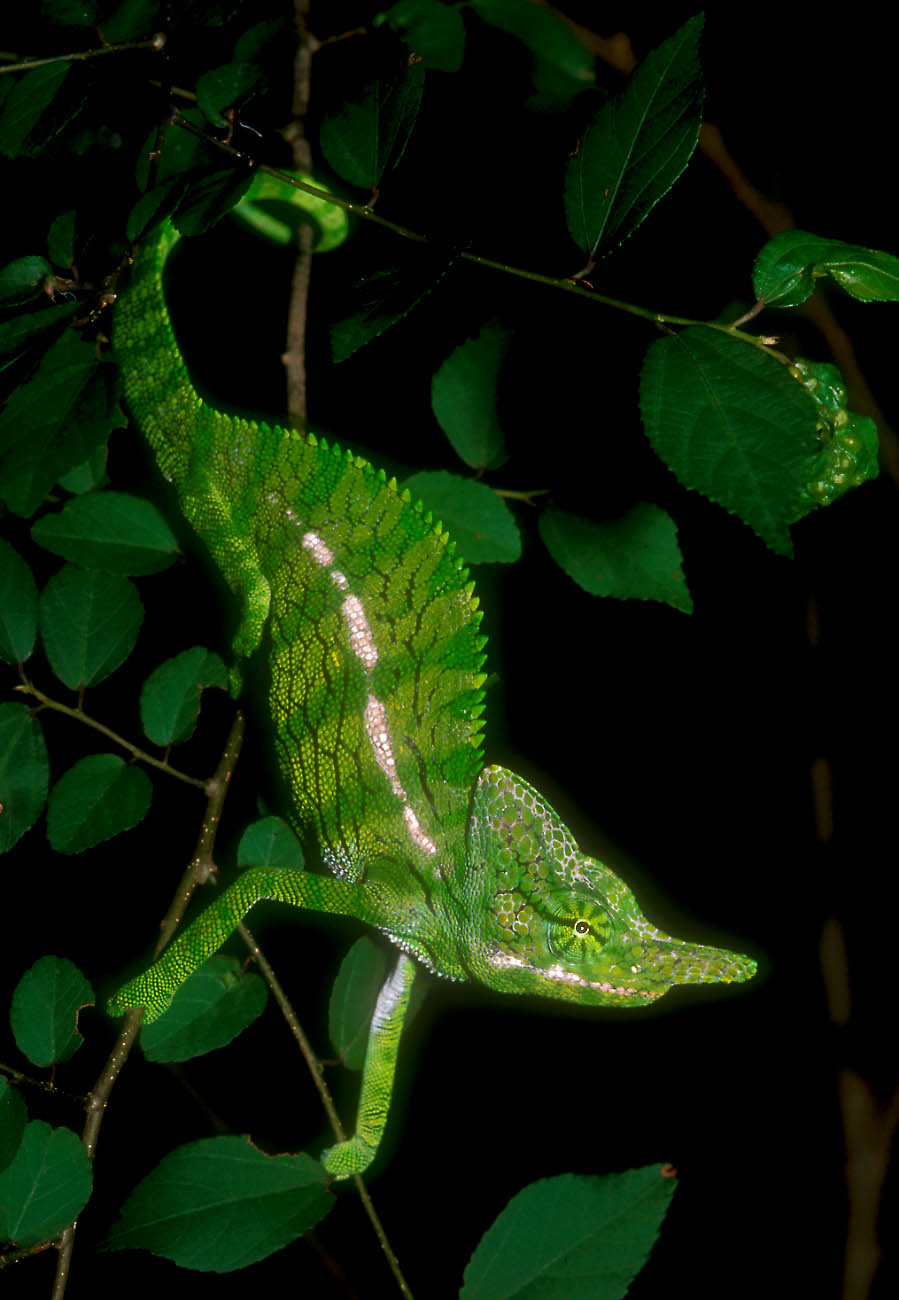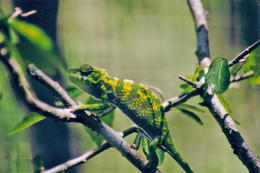Chameleon Species Is Born & Dies In Year
Posted by: Loren Coleman on July 4th, 2008
OSU Press Release by John David Sutter

An Oklahoma State University researcher gained national attention this week for figuring out that a bizarre chameleon species on the island of Madagascar is born and dies within a year.
For more than 100 years, people had known about the tiny chameleon species Furcifer labordi, but no one noticed that it was living a furious life in hyper-drive — a life more like those of annual plants or short-lived insects than that of an animal with a spine, said Kris Karsten, the OSU student who published his doctorate research this week in the “Proceeding of the National Academy of Sciences.”
“It really exemplifies how little we know about a lot of the world,” Karsten said.
Many plants and insects live and die in a year. But among four-legged vertebrates, such a quick life is almost unheard of, Karsten said in an interview.
Fast life may aid survival
For F. labordi, the fast life may be an evolutionary strategy for survival and reproduction, Karsten said.
The chameleon lives in “barren wasteland” desert conditions in southwest Madagascar, a massive island on the Indian Ocean side of Africa.
Chameleons have a tough time living through the dry season. Some bury themselves in the sand in hopes of survival, he said, but that doesn’t always work. Many dry out and die.
The small animal seems to have been selected for an adaptive strategy: its species may have a better chance of survival when living inside a moist egg than when it’s left to face the harsh elements bare, Karsten said.

Furcifer labordi
The chameleon lives four or five months out of its yearlong life, trapped in an egg. It grows to full size — less than 4 inches long — at an incredible rate, Karsten said.
Once the chameleon hatches, it reproduces and dies.
The chameleons mate furiously, using extensions on their noses and skulls to fight each other and attract attention, Karsten said.
“There’s not a lot of room for error,” Karsten said. “If you’re a male chameleon of this species and you can’t find a female to convince to mate, you’ve got no offspring in the next generation.”
Habits intrigued student
It was those strange mating patterns that first drew Karsten to Madagascar to study the chameleons. He had no idea their life cycles were so odd.
Not long after Karsten arrived in the country, though, all of the individuals he’d set out to observe died off all at once, he said.
Karsten was confused and frustrated.
His chance to observe the chameleons and collect information about them seemed finished.
But over four years, Karsten and colleagues in Madagascar and the U.S. returned to observe the chameleons, documenting the same “very bizarre” cycle of life and death among 400 individuals, Karsten said.
Karsten, who is a native of Kansas City, Mo., received his Ph.D. from OSU in May.
He said he hopes the discovery is inspiring to young scientists.
Students at OSU sometimes say they’re disappointed that everything interesting about science has been figured out, he said.
But Karsten finds it thrilling that people still don’t understand the basics of ecology.
About Loren Coleman
Loren Coleman is one of the world’s leading cryptozoologists, some say “the” leading living cryptozoologist. Certainly, he is acknowledged as the current living American researcher and writer who has most popularized cryptozoology in the late 20th and early 21st centuries.
Starting his fieldwork and investigations in 1960, after traveling and trekking extensively in pursuit of cryptozoological mysteries, Coleman began writing to share his experiences in 1969. An honorary member of Ivan T. Sanderson’s Society for the Investigation of the Unexplained in the 1970s, Coleman has been bestowed with similar honorary memberships of the North Idaho College Cryptozoology Club in 1983, and in subsequent years, that of the British Columbia Scientific Cryptozoology Club, CryptoSafari International, and other international organizations. He was also a Life Member and Benefactor of the International Society of Cryptozoology (now-defunct).
Loren Coleman’s daily blog, as a member of the Cryptomundo Team, served as an ongoing avenue of communication for the ever-growing body of cryptozoo news from 2005 through 2013. He returned as an infrequent contributor beginning Halloween week of 2015.
Coleman is the founder in 2003, and current director of the International Cryptozoology Museum in Portland, Maine.










Very interesting. I wonder what’s the heart rate of this little reptile.
Wow, thats very strange. I wonder, would they last longer in captivity?
Evolution at its werdest.